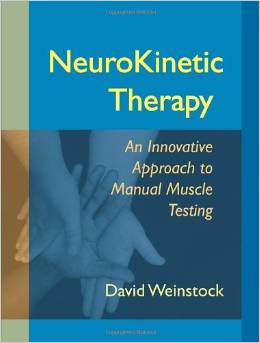 Developed by David Weinstock, NKT is a method of assessing function and dysfunction in movement patterns. It draws together an encyclopedic knowledge of anatomy, some concepts from Applied Kinesiology (without the mumbo jumbo of AK), some of the SFMA examination tools, concepts from Anatomy Trains and an understanding of how the motor control centre in the cerebellum learns from failure. Movements never involve only one muscle. For a joint to move in one direction, one or more muscles need to contract and others need to relax. Complex movements require multiple muscles to contract (just the right amount), and others to relax, in the correct sequence. When we learn to perform a particular action, whether it is picking out chords on the guitar, pitching a baseball or learning to walk, the brain learns from trial and error. If a particular sequence of muscle movements does not achieve the desired result then one tries again until success is achieved. Repetition burns the movement pattern into the subconscious memory of the motor control centre so that, once mastered, one can achieve the movement without even thinking about it. If an injury occurs or a muscle or group of muscles is over-used or not functioning, one may learn a different sequence, or use alternative muscles to compensate for the dysfunction. This can lead to poor posture, pain and impaired function. It takes more repetitions to unlearn a dysfunctional pattern than to learn a functional one. Generally in medicine, orthopedics, physiotherapy, etc, one is dealing with the hardware of the body - bones, ligaments, joints, tendons, muscles. NKT uses a knowledge of the hardware, but chiefly addresses the software - how neural connections between the brain and muscles produce complex movement patterns which may have become dysfunctional due to habits, posture, old injuries or surgery, and then corrects them. In NKT muscle movements are tested and when one fails a brief learning opportunity is awakened in the motor control centre for new learning to take place. Muscles which are over-active ("facilitated") can be released by whichever method is within the practitioner's scope of practice and exercises can be given as homework to produce improved function. It has been an amazing and challenging adventure to learn these new concepts alongside physiotherapists, chiropractors, massage therapists, Pilates instructors and kinesiologists and observe how each profession can bring their skills to bear on the same problems. Here is some information about David Weinstock's book. The book is most useful as an adjunct to the training seminars and is not as useful if one has not taken the training. "NeuroKinetic Therapy® corrective movement system is based on the premise that when an injury has occurred, certain muscles shut down or become inhibited, forcing other muscles to become overworked. By applying light pressure that the client then resists, the practitioner can evaluate the strength or weakness of each muscle, revealing the sources of injury and retraining the client’s body to remove the compensation patterns. This easy-to-follow practitioner’s manual presents a series of muscle tests specially designed to uncover and resolve compensation patterns in the body. Author David Weinstock begins by explaining how this approach stimulates the body and mind to resolve pain. Organized anatomically, each section of the book includes clear photographs demonstrating correct positioning of the muscle accompanied by concise explanations and instructions. Labeled anatomical illustrations appear at the end of each section showing the relationships between the muscles and muscle groups. This essential resource is especially useful for physical therapists, chiropractors, orthopedists, and massage therapists looking for new ways to treat underlying causes of pain. The book is intended for those practitioners who are serious about affecting change in their clients." When you learn NKT you join an incredibly-supportive and diverse community of therapists. I must admit that NKT is quite different in concept from what we as physicians learned at medical school. We have only recently began our own journey toward incorporating this modality into our MSK practice. It is quite humbling to be at the bottom of a very steep learning curve and to witness practitioners with a very different training background master these techniques and solve problems which very accomplished specialists or other physicians were unable to do. But it is a privilege to learn from and along side them and to share this experience. |
AuthorDavid is a fan of books and no doubt will be sharing some good reads here. Archives
February 2024
Categories
All
|
 RSS Feed
RSS Feed